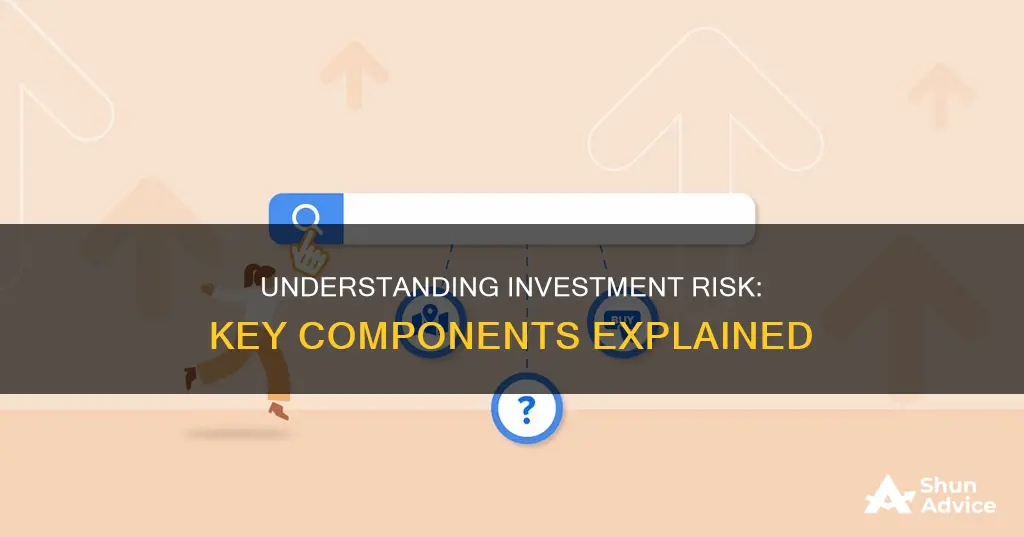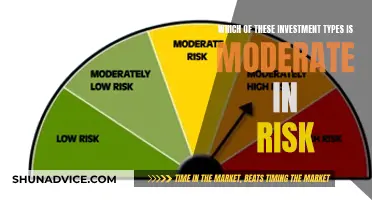
Investment risk is the possibility that an investment's actual returns may differ from the expected returns, potentially resulting in financial loss. In other words, when you invest in something, there is no guarantee that you will make a return at all, and you may even face unexpected losses. Investment risk is inescapable, but it is also relative. It is important to understand the different types of investment risk and your own risk tolerance to make informed investment decisions and work towards your financial goals.
| Characteristics | Values |
|---|---|
| Project-specific risk | Higher or lower cashflows than expected |
| Competitive risk | Earnings and cashflows affected by competitors' actions |
| Industry-specific risk | Technology, legal and commodity risks |
| International risk | Unexpected exchange rate movements or political developments |
| Market risk | Macroeconomic factors such as interest rates, term structure, inflation, and economic growth |
| Business risk | Corporate decisions and performance |
| Political risk | Events in the country of investment |
| Currency risk | Fluctuations in exchange rates |
| Liquidity risk | Difficulty cashing out of an investment |
| Concentration risk | Having a large portion of an investment portfolio allocated to a single asset or sector |
| Credit risk | Default by the issuer of the bond |
| Interest rate risk | Changes in interest rates |
| Inflation risk | Reduction in purchasing power |
| Operational risk | Inadequate or failed internal processes, systems, or human actions |
What You'll Learn
- Market risk: the potential for an investment to lose value due to factors affecting the entire market
- Credit risk: the risk of a borrower defaulting on their debt obligations
- Liquidity risk: the risk of being unable to buy or sell an asset at a reasonable price within a desired timeframe
- Operational risk: the risk of loss due to inadequate or failed internal processes, systems or human actions
- Inflation risk: the risk of the purchasing power of an investment's returns being eroded by inflation

Market risk: the potential for an investment to lose value due to factors affecting the entire market
Market risk, also known as systematic risk, is the potential for an investment to lose value due to factors affecting the entire market. It is important to note that market risk is inherent in any investment and cannot be entirely eliminated. However, investors can take steps to manage and mitigate this risk.
Market risk arises when external factors impact the overall market, causing investments to lose value. These factors can include economic conditions, political events, and geopolitical issues. For example, a stock market crash or a significant geopolitical event can negatively affect most investments, regardless of their individual merits. Market risk also encompasses the impact of macroeconomic factors such as changes in interest rates, the term structure (the difference between short and long-term rates), inflation, and economic growth. These factors can affect the value of investments across the board, making market risk a significant concern for investors.
To manage market risk, investors can employ diversification and asset allocation strategies. By investing in a variety of asset classes and sectors, investors can reduce their exposure to any single market event. This diversification helps to minimize the potential impact of market risk on their overall portfolio. Additionally, investors can consider investing in assets that are less sensitive to market risk, such as real estate or currency-hedged funds.
It is worth noting that market risk is different from unsystematic risk, which only affects a specific industry or company. While unsystematic risk can be mitigated through diversification, market risk is more challenging to mitigate due to its broad impact on the market as a whole.
Overall, market risk is an inherent part of investing, and it is essential for investors to understand and manage this risk effectively to make informed investment decisions and protect their portfolios.
Equity Investment Impacts: Understanding Balance Sheet Changes
You may want to see also

Credit risk: the risk of a borrower defaulting on their debt obligations
Credit risk is the risk that a borrower will default on their debt obligations. It is one of the components of investment risk and is particularly concerning to investors who hold bonds in their portfolios. Default risk, a sub-category of credit risk, is the risk that a borrower will default on or fail to repay their debts. This can include loans, bonds, or credit cards.
The level of default risk depends on the borrower's capacity to make their debt payments on time. This capacity is influenced by the debtor's financial health, including profitability, cash flows, coverage ratios, liquidity, and leverage. A borrower with high levels of debt relative to their cash flows or assets will be less creditworthy.
There are two drivers of default risk: business risk and financial risk. Business risk assesses external and internal factors affecting the borrower's business environment, including country-specific, industry-specific, and company-specific risks. Country-specific risks include economic, institutional, regulatory, governance, and financial system-related factors. Industry-specific risks include growth trends, market structure, and cyclicality. Company-specific risks include competitive dynamics, operating efficiency, profitability, market share, and management quality.
Financial risk, on the other hand, is a quantitative and qualitative assessment of the borrower's ability to service and repay loans. It considers the borrower's cash flows, liquidity, earnings, and asset quality.
Credit ratings provided by agencies such as Standard & Poor's (S&P), Moody's, and Fitch play a crucial role in assessing default risk. These ratings reflect the credit quality of bonds issued by companies and are intended to evaluate the risk of default. The higher the credit rating, the lower the default risk.
Lenders compensate for higher levels of default risk by charging increased interest rates on loans. A borrower with a high default risk will typically pay higher interest rates.
Default risk is a key factor in determining the price and yield of financial instruments. Issuers of bonds with higher default risk may struggle to access capital markets, impacting their funding potential.
Rich People's Secrets: Unveiling Their Investment Strategies
You may want to see also

Liquidity risk: the risk of being unable to buy or sell an asset at a reasonable price within a desired timeframe
Liquidity risk is a type of financial risk that impacts a wide range of entities, including individuals, corporations, and financial institutions. It refers to the potential challenges in fulfilling short-term financial obligations due to insufficient cash or the inability to convert assets into cash without incurring significant losses. This risk arises when there is a mismatch between assets and liabilities, and it can have severe repercussions if not managed effectively.
The key components of liquidity risk include:
- Market Liquidity Risk: This occurs when an entity cannot execute transactions at prevailing market prices due to insufficient market depth, a lack of buyers, or market disruptions. It is more prevalent in illiquid or low-volume markets.
- Funding Liquidity Risk: This pertains to the challenges faced by an entity in obtaining the necessary funds to meet its short-term financial obligations. It may be a result of cash mismanagement, creditworthiness issues, or unfavourable market conditions.
The impact of liquidity risk can be mitigated by implementing effective risk management strategies. For individuals, this may involve maintaining an emergency fund and diversifying investments. Corporations can establish revolving credit facilities, maintain cash reserves, and engage in effective cash flow forecasting. Financial institutions, such as banks, adhere to regulatory frameworks like Basel III, which enforces stringent liquidity standards to ensure financial stability.
Liquidity risk is an important consideration for investors as it directly affects their ability to buy or sell assets. It is crucial to assess this risk when making investment decisions to ensure that assets can be traded without significantly impacting the market price and to prevent potential financial losses.
Overall, liquidity risk plays a significant role in investment risk assessment and management, and it is essential to address this risk through careful planning and proactive strategies to ensure financial stability.
How to Make Your Portfolio Invest Itself
You may want to see also

Operational risk: the risk of loss due to inadequate or failed internal processes, systems or human actions
Operational risk is a critical component of investment risk, encompassing the potential for losses due to inadequate or failed internal processes, systems, or human actions. It is distinct from systematic risk, which arises from external factors such as economic or political events. Operational risk is closely tied to human error and internal decision-making, making it an important consideration for investors.
Operational risk management is essential for addressing these uncertainties and hazards. It involves identifying, assessing, and mitigating risks to prevent financial losses and disruptions. Companies must evaluate their internal procedures, staff capabilities, and systems to minimise the likelihood and impact of potential losses. This includes anticipating risks, conducting cost-benefit analyses, and delegating strategic planning to upper management.
Operational risk arises from four main sources: people, processes, systems, and external events. People-related risks include employee deficiencies, shortages, or fraudulent activities. Process-related risks involve sequential steps that, if not properly defined or documented, can lead to detrimental outcomes. Systems may be outdated, inadequate, or prone to technical failures, increasing the risk of cybercrime. External events, such as natural disasters or political changes, can also impact a company's operations.
To effectively manage operational risk, companies should follow these key strategies:
- Avoid Unnecessary Risk: Evaluate and eliminate processes that incur unnecessary risks without providing sufficient rewards.
- Conduct a Cost/Benefit Analysis: Compare the risks and benefits of business decisions to ensure that the potential gains outweigh the risks taken.
- Delegate Decisions to Upper Management: Upper management often has a broader perspective and can make more informed decisions about operational risk.
- Anticipate and Plan: Identify potential risks and develop strategies to address them before they occur.
By implementing these strategies, companies can better manage operational risk and create a more resilient and stable investment environment.
FDI vs Portfolio Investment: Understanding the Key Differences
You may want to see also

Inflation risk: the risk of the purchasing power of an investment's returns being eroded by inflation
Inflation risk is the risk that the purchasing power of an investment's returns will be diminished by inflation. Inflation is the decline in the purchasing power of money over time, and it affects all areas of the economy. As inflation occurs, money 'buys less' over time. This means that even if an investment generates returns, those returns may not be sufficient to keep up with the rising cost of living.
Inflation risk is particularly relevant for fixed-income investments, such as bonds, where the income stream remains the same until maturity. As inflation rises, the purchasing power of the interest payments declines, and the real value of the returned principal investment decreases. For example, if an investor buys a 30-year bond with a fixed coupon rate of 4% but inflation skyrockets to 12%, the investor's purchasing power decreases with each passing year, resulting in a significant loss.
Inflation risk also affects savings and cash investments. When there is no interest being generated to compete with the rate of inflation, it can quickly eat into the purchasing power of cash. Even conservative, insured investments, such as certificates of deposit (CDs), are vulnerable to inflation risk and may not earn enough over time to keep up with the increasing cost of living.
To counteract inflation risk, investors can build an inflation premium into the interest rate or required rate of return (RoR) for an investment. This involves adding the expected decline in the value of money over a given period to the interest rate charged. Additionally, certain securities, such as Treasury Inflation-Protected Securities (TIPS), adjust their cash flows according to changes in the consumer price index (CPI), providing investors with a guaranteed real return based on the actual inflation rate.
It is important to note that not all investments are equally affected by inflation risk. Real assets, such as commodities and real estate, tend to have a positive relationship with inflation. Commodities, particularly energy-related commodities like oil, and precious metals, often rise in value during periods of accelerating inflation. Similarly, property owners may increase rent payments in line with the CPI, which can positively impact profits and investor distributions.
Crafting a Diversified Portfolio with Fidelity Investments
You may want to see also
Frequently asked questions
Investment risk refers to the possibility of losing money or not achieving the expected return on an investment. It is the uncertainty related to investing and is inherent in any investment decision.
There are several types of investment risk, including market risk, inflation risk, interest rate risk, credit risk, liquidity risk, operational risk, currency risk, and concentration risk.
Investment risk can impact your financial goals by affecting the returns on your investments. Understanding and managing investment risk can help you make more informed decisions and increase the likelihood of achieving your financial goals.
No, investment risk cannot be completely eliminated. However, it can be managed and mitigated through various strategies such as diversification, asset allocation, and hedging.
You can mitigate investment risk by diversifying your portfolio across different asset classes, sectors, and regions. Additionally, investing in low-risk securities, setting realistic investment goals, and regularly monitoring your investments can help reduce risk.







